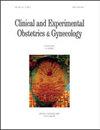Human papillomavirus vaccine uptake in South Korea
IF 0.6
4区 医学
Q4 OBSTETRICS & GYNECOLOGY
引用次数: 2
Abstract
Background: This study aimed to assess the human papillomavirus (HPV) vaccine uptake rate in South Korean women and to identify factors affecting vaccination rate before initiation of the national HPV vaccination as a National Immunization Program (NIP) in Korea. Materials and methods: We conducted online survey in February 2016 with questions to 2000 women aged between 9 and 59 years in South Korea by distribution of age and region, to assess HPV uptake and associated correlates such as age, residential region, education, and socioeconomic status. Results: The overall HPV vaccine received at least 1 dose rate was 23.1%, and the highest rate of vaccination was observed in women aged 20–29 years (38.6%), followed by those aged 30–39 years (36.9%), 9–19 years (16.9%), 40–49 years (14.2%), and 50–59 years (12.5%). Factors affecting HPV vaccination included metropolitan cities (odds ratio [OR] = 1.44, 95% confidence interval [CI], 1.15–1.80), university graduate (OR = 1.45, 95% CI, 1.06–2.00), regular influenza vaccination (OR = 2.11, 95% CI, 1.64–2.70), visited clinic within the last 6 months (OR = 1.73, 95% CI, 1.20–2.51) and high family income (OR = 1.55, 95% CI, 1.01–2.37). Conclusion: HPV vaccine uptake is low in South Korean women. Correct publicity, education and economic support programs for HPV vaccine could play an important role in increasing HPV vaccine uptake in South Korea.韩国接种人乳头瘤病毒疫苗的情况
背景:本研究旨在评估韩国女性人乳头瘤病毒(HPV)疫苗的接种率,并在韩国开始将HPV疫苗接种作为国家免疫规划(NIP)之前确定影响疫苗接种率的因素。材料和方法:我们于2016年2月对韩国2000名年龄在9至59岁之间的女性进行了在线调查,按年龄和地区分布,评估HPV感染情况及其相关因素,如年龄、居住地、教育程度和社会经济地位。结果:HPV疫苗总接种率为23.1%,其中20 ~ 29岁女性接种率最高(38.6%),其次为30 ~ 39岁(36.9%)、9 ~ 19岁(16.9%)、40 ~ 49岁(14.2%)、50 ~ 59岁(12.5%)。影响HPV疫苗接种的因素包括大城市(优势比[OR] = 1.44, 95%可信区间[CI], 1.15-1.80)、大学毕业生(OR = 1.45, 95% CI, 1.06-2.00)、定期接种流感疫苗(OR = 2.11, 95% CI, 1.64-2.70)、最近6个月内就诊(OR = 1.73, 95% CI, 1.20-2.51)和高家庭收入(OR = 1.55, 95% CI, 1.01-2.37)。结论:韩国女性HPV疫苗接种率较低。正确的HPV疫苗宣传、教育和经济支持计划可以在提高韩国HPV疫苗接种率方面发挥重要作用。
本文章由计算机程序翻译,如有差异,请以英文原文为准。
求助全文
约1分钟内获得全文
求助全文
来源期刊
CiteScore
0.50
自引率
0.00%
发文量
241
审稿时长
1 months
期刊介绍:
CEOG is an international, peer-reviewed, open access journal. CEOG covers all aspects of Obstetrics and Gynecology, including obstetrics, prenatal diagnosis, maternal-fetal medicine, perinatology, general gynecology, gynecologic oncology, uro-gynecology, reproductive medicine, infertility, reproductive endocrinology, sexual medicine. All submissions of cutting-edge advances of medical research in the area of women''s health worldwide are encouraged.

 求助内容:
求助内容: 应助结果提醒方式:
应助结果提醒方式:


